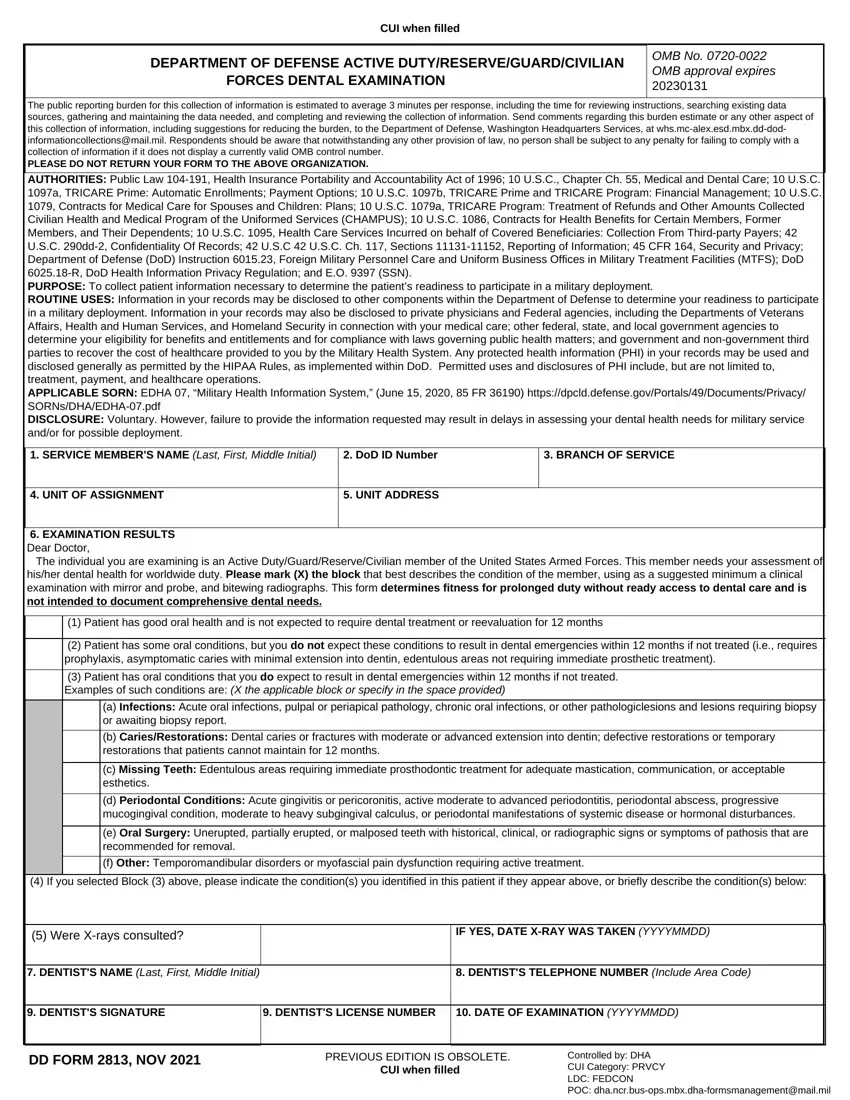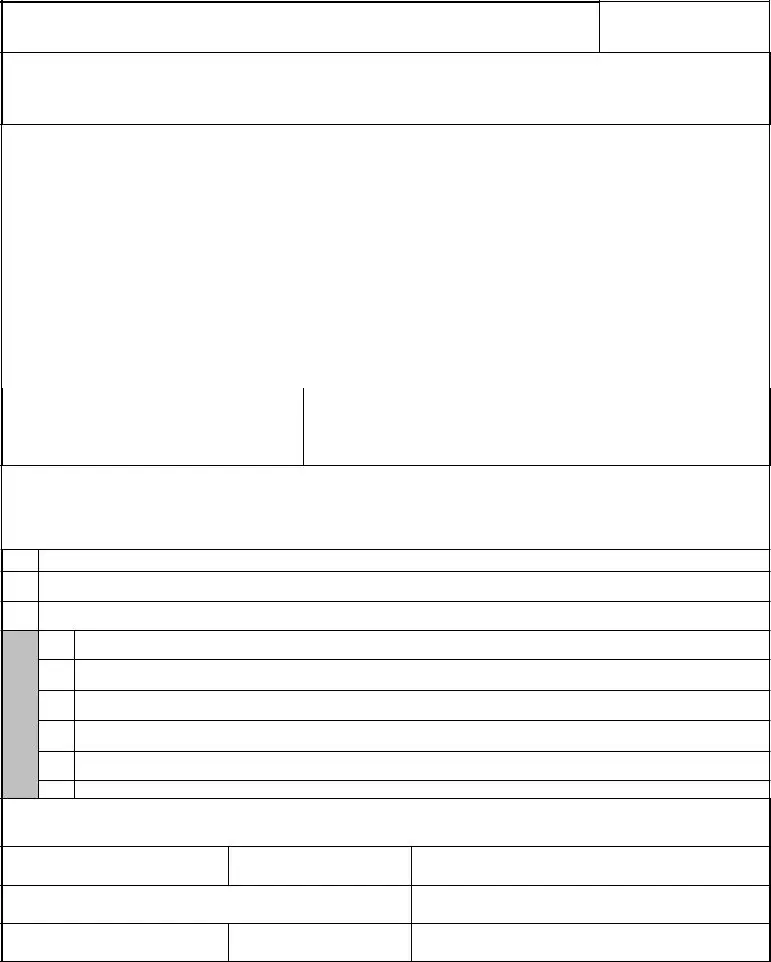The public reporting burden for this collection of information is estimated to average 3 minutes per response, including the time for reviewing instructions, searching existing data sources, gathering and maintaining the data needed, and completing and reviewing the collection of information. Send comments regarding this burden estimate or any other aspect of this collection of information, including suggestions for reducing the burden, to the Department of Defense, Washington Headquarters Services, at whs.mc-alex.esd.mbx.dd-dod- informationcollections@mail.mil. Respondents should be aware that notwithstanding any other provision of law, no person shall be subject to any penalty for failing to comply with a collection of information if it does not display a currently valid OMB control number.
PLEASE DO NOT RETURN YOUR FORM TO THE ABOVE ORGANIZATION.
AUTHORITIES: Public Law 104-191, Health Insurance Portability and Accountability Act of 1996; 10 U.S.C., Chapter Ch. 55, Medical and Dental Care; 10 U.S.C.
1097a, TRICARE Prime: Automatic Enrollments; Payment Options; 10 U.S.C. 1097b, TRICARE Prime and TRICARE Program: Financial Management; 10 U.S.C.
1079, Contracts for Medical Care for Spouses and Children: Plans; 10 U.S.C. 1079a, TRICARE Program: Treatment of Refunds and Other Amounts Collected Civilian Health and Medical Program of the Uniformed Services (CHAMPUS); 10 U.S.C. 1086, Contracts for Health Benefits for Certain Members, Former Members, and Their Dependents; 10 U.S.C. 1095, Health Care Services Incurred on behalf of Covered Beneficiaries: Collection From Third-party Payers; 42 U.S.C. 290dd-2, Confidentiality Of Records; 42 U.S.C 42 U.S.C. Ch. 117, Sections 11131-11152, Reporting of Information; 45 CFR 164, Security and Privacy; Department of Defense (DoD) Instruction 6015.23, Foreign Military Personnel Care and Uniform Business Offices in Military Treatment Facilities (MTFS); DoD 6025.18-R, DoD Health Information Privacy Regulation; and E.O. 9397 (SSN).
PURPOSE: To collect patient information necessary to determine the patient’s readiness to participate in a military deployment.
ROUTINE USES: Information in your records may be disclosed to other components within the Department of Defense to determine your readiness to participate in a military deployment. Information in your records may also be disclosed to private physicians and Federal agencies, including the Departments of Veterans Affairs, Health and Human Services, and Homeland Security in connection with your medical care; other federal, state, and local government agencies to determine your eligibility for benefits and entitlements and for compliance with laws governing public health matters; and government and non-government third parties to recover the cost of healthcare provided to you by the Military Health System. Any protected health information (PHI) in your records may be used and disclosed generally as permitted by the HIPAA Rules, as implemented within DoD. Permitted uses and disclosures of PHI include, but are not limited to, treatment, payment, and healthcare operations.
APPLICABLE SORN: EDHA 07, “Military Health Information System,” (June 15, 2020, 85 FR 36190) https://dpcld.defense.gov/Portals/49/Documents/Privacy/ SORNs/DHA/EDHA-07.pdf
DISCLOSURE: Voluntary. However, failure to provide the information requested may result in delays in assessing your dental health needs for military service and/or for possible deployment.
1. SERVICE MEMBER'S NAME (Last, First, Middle Initial) |
2. DoD ID Number |
3. BRANCH OF SERVICE |
|
|
|
4. UNIT OF ASSIGNMENT |
5. UNIT ADDRESS |
|
6.EXAMINATION RESULTS Dear Doctor,
The individual you are examining is an Active Duty/Guard/Reserve/Civilian member of the United States Armed Forces. This member needs your assessment of his/her dental health for worldwide duty. Please mark (X) the block that best describes the condition of the member, using as a suggested minimum a clinical examination with mirror and probe, and bitewing radiographs. This form determines fitness for prolonged duty without ready access to dental care and is not intended to document comprehensive dental needs.
(1)Patient has good oral health and is not expected to require dental treatment or reevaluation for 12 months
(2)Patient has some oral conditions, but you do not expect these conditions to result in dental emergencies within 12 months if not treated (i.e., requires prophylaxis, asymptomatic caries with minimal extension into dentin, edentulous areas not requiring immediate prosthetic treatment).
(3)Patient has oral conditions that you do expect to result in dental emergencies within 12 months if not treated.
Examples of such conditions are: (X the applicable block or specify in the space provided)
(a)Infections: Acute oral infections, pulpal or periapical pathology, chronic oral infections, or other pathologiclesions and lesions requiring biopsy or awaiting biopsy report.
(b)Caries/Restorations: Dental caries or fractures with moderate or advanced extension into dentin; defective restorations or temporary restorations that patients cannot maintain for 12 months.
(c)Missing Teeth: Edentulous areas requiring immediate prosthodontic treatment for adequate mastication, communication, or acceptable esthetics.
(d)Periodontal Conditions: Acute gingivitis or pericoronitis, active moderate to advanced periodontitis, periodontal abscess, progressive
mucogingival condition, moderate to heavy subgingival calculus, or periodontal manifestations of systemic disease or hormonal disturbances.
(e)Oral Surgery: Unerupted, partially erupted, or malposed teeth with historical, clinical, or radiographic signs or symptoms of pathosis that are recommended for removal.
(f) Other: Temporomandibular disorders or myofascial pain dysfunction requiring active treatment.
(4) If you selected Block (3) above, please indicate the condition(s) you identified in this patient if they appear above, or briefly describe the condition(s) below:




